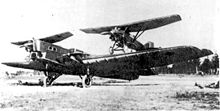Tupolev TB-1 Video - Wings of Russia - Amphibians - The Steel Albatross
|
|
Tupolev TB-1
TB-1
Picture - ANT-4 at the Ulyanovsk Aircraft Museum
Role: Bomber
National origin: Soviet Union
Manufacturer: Tupolev
First flight: 26 November 1925
Introduction: 1929
Retired: 1948
Primary users: Soviet Air Forces
Aeroflot
Number built: 218
The Tupolev TB-1 (development name ANT-4) was a Soviet bomber aircraft, an angular monoplane that served as the backbone of the Soviet bomber force for many years, and was the first large all-metal aircraft built in the Soviet Union.
Design and development
In 1924, the Soviet Air Force instructed TsAGI, (ЦенÑÑаÌлÑнÑй аÑÑогидÑодинамиÌÑеÑкий инÑÑиÑÑÌÑ (ЦÐÐÐ) - Tsentralniy Aerogidrodinamicheskiy Institut or Central Aerohydrodynamic Institute) to design a heavy-bomber. TsAGI gave the task to the division lead by Andrei Tupolev. Tupolev's team designed a twin engined all-metal monoplane with a corrugated Duralumin skin, powered by two Napier Lion engines, the ANT-4.
The first prototype was built during 1925 on the second floor of Tupolev's factory in Moscow, it being necessary to knock down a wall to allow the aircraft to taken out of the building in pieces. After re-assembly at Moscow's Khodynka Airport, it was flown on 26 November 1925.
Testing was successful, and it was decided to put the ANT-4 into production as the TB-1. Production was delayed, however, by shortages of Aluminium, and by the need to find a replacement for the expensive imported Lion engines, the BMW VI (and later by the Soviet licence built version, the Mikulin M-17). Production eventually started at the ex-Junkers factory at Fili, Moscow in 1929, 216 following the two prototypes, production continuing until 1932.
Operational history
The first production aircraft was completed as an unarmed civil aircraft, named Strana Sovyetov (Land of the Soviets) for a propaganda flight from Moscow to New York, taking an eastward course via Siberia, reaching its destination on 3 November, flying 21,242 km (13,194 mi) in 137 flying hours. The TB-1 became the Soviet Air Forces' first standard heavy bomber, also being fitted with floats for use as a torpedo bomber (TB-1P), and for aerial survey operations.

Picture - Zveno-1: Tupolev TB-1 and two Tupolev I-4
It was also widely used for experimental purposes, being the first mothership used in the Zveno Parasite aircraft project, carrying two I-4 fighters over the aircraft's wings.
The TB-1 was replaced as a heavy bomber by the similar, but much larger, four engined Tupolev TB-3, with many aircraft being converted to civil freighters (designated G-1) for use by Aeroflot and Aviaarktika, Aeroflot's polar division. One Avia Arktika ANT-4, flown by Anatoly Liapidevsky played a key role in the rescue of the crew of the steamship Chelyuskin, which sank on 12 February 1934 after being trapped in ice near the Bering Strait, Liapidevsky being awarded the title of Hero of the Soviet Union. G-1s continued in used with Avia Arktika until 1948.
Variants
TB-1 : Twin-engined heavy bomber aircraft. Also known as the ANT-4.
ANT-4bis : Third prototype.
TB-1P : Twin-float torpedo-bomber seaplane.
G-1 : Twin-engined transport aircraft.
Survivors
One ANT-4, an ex-Aviaarktika Tupolev G-1, survives, being preserved at the Ulyanovsk Civil Aviation Museum.
Operators
Soviet Union
Aeroflot
Soviet Air Force
Specifications (TB-1)
Data from The Osprey Encyclopedia of Russian Aircraft 1875-1995
General characteristics
Crew: 6
Length: 18.00 m (59 ft 0â
in)
Wingspan: 28.7 m (94 ft 2 in)
Height: 5.1 m (16 ft 8¾ in)
Wing area: 120.0 m² (1,292 ft²)
Empty weight: 4,520 kg (9,965 lb)
Loaded weight: 6,810 kg (15,013 lb)
Powerplant: 2x M-17 V-12 liquid-cooled piston engine], 510 kW (680 hp) each
Performance
Maximum speed: 178 km/h (146 kt, 111 mph)
Cruise speed: 156 km/h (84 knots, 97 mph)
Range: 1,000 km (540 nm, 621 mi)
Service ceiling: 4,830 m (15,846 ft)
Rate of climb: 3.03 m/s (596 ft/min)
Wing loading: 56.8 kg/m² (11.6 lb/ft²)
Power/mass: 0.15 kW/kg (0.091 hp/lb)
Armament
Guns: 6 x DA machine guns
Bombs: 1,000 kg (2,205 lb)
Related development
Tupolev TB-3
Tupolev R-6
Duffy, Paul and Andrei Kandalov. Tupolev: The Man and His Aircraft. Shrewsbury, UK:Airlife Publishing, 1996. ISBN 1 85310 728 X.
Gunston, Bill. The Osprey Encyclopedia of Russian Aircraft 1875-1995. London:Osprey, 1995. ISBN 1 85532 405 9.
The initial version of this article was based on material from aviation.ru. It has been released under the GFDL by the copyright holder.
Living Warbirds: The best warbirds DVD series.
Source: WikiPedia